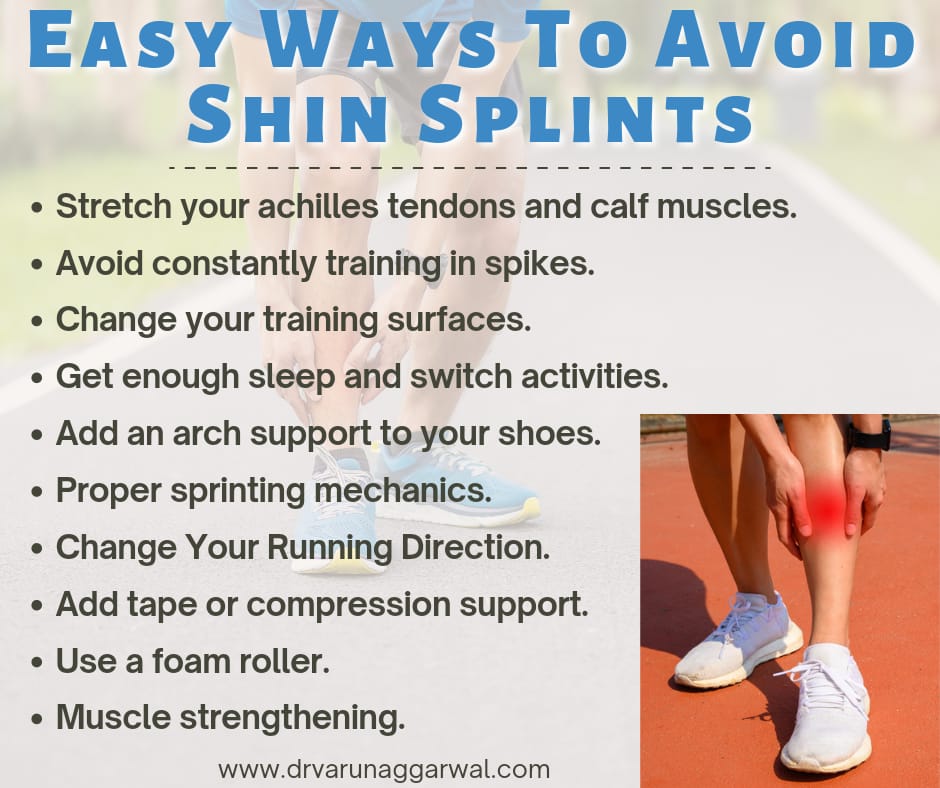Shin splints, also known as “medial tibial stress syndrome,” are common running injuries. If you’ve ever suffered shin splints, you know that they’re awful! They can be exceedingly painful and a big disadvantage to your training and sporting ambitions. Any sport requiring vigorous activity, such as soccer, basketball, or sprinting, can result in shin splints. Shin splints typically cause pain on the front side of the shin (anterior shin splints) or the back inside of the shin (posterior medial shin splints). Even though this injury is common, particularly in new runners, there are steps you can take to avoid it. So, in this blog, I am going to tell you about some easy ways to avoid and treat Shin splints.

Easy Ways To Avoid Shin Splints
Stretch your achilles tendons and calf muscles
Tightness around your Achilles tendons and calf muscles might contribute to shin splints. Stretch your muscles everyday or every other day, depending on how tight they are. Insufficient stretching not only increases your risk of multiple injuries, but it may also be directly responsible for your shin problems. Stretch for a significant amount of time using a variety of static and dynamic stretches.
Avoid constantly training in spikes
Training several times a week using Spikes puts a lot of stress on the shins and calves of sportspersons.
Spikes are not designed to give the foot much support. As a result, repeated use every session can result in chronic injuries like shin splints.
It is recommended that spikes should only be worn during sets performed at or close to competition speed. Work done at lower intensities should be done barefoot or in trainers.
Change your training surfaces
Be conscious of the type of surface you are practicing on. While hard tracks are great for running at high speeds in competition, they can be brutal on the shins and joints when used on a daily basis. As you hit a hard surface from your ankle to knee, the impact can wreak havoc on your anterior tibialis.
Train on grass if you can. Grass is perfect for bounding, drills and other repetitive exercises. If you experience any pain in the shin, I recommend not training on the hard track until the pain is completely gone. The adverse effect of grass will be very less.
Get enough sleep and switch activities
Shin splints are the result of overuse. Therefore, it is necessary to take adequate rest to avoid this injury. If you’ve ever had this injury, you should take double precautions. Even if you feel fine, shin splints have a terrible habit of reappearing, so I recommend changing your activity. Try swimming and cycling as they are fantastic ways to promote rehabilitation whilst still being active.
Add an arch support to your shoes
First, look at your foot’s arch. Your lower legs are naturally placed under more stress if you’re flatfooted. This could be the cause of numerous additional issues. Supporting the arch or wearing insoles can really help alleviate pain and stress. Spend some time developing more strength in your lower legs. You should eventually be able to remove the support from your feet, ankles, and shins.
Proper sprinting mechanics
Shin splints can be avoided by using proper sprinting mechanics. Athletes usually hit the ground very hard. Their duration of foot-to-earth contact is excessively long and/or they hit the ground from the wrong area of the foot. It actually produces a different sound.
If you hear a ‘thud’ with each foot strike while running on the track, you are hitting the ground too hard. Doing this again and again will surely result in shin splints or any other kind of damage. To make your leg cycle as rapid as possible, you should scrape your spikes against the track surface.
Change Your Running Direction
During training, be sure to run in both directions. For example, 400 m sprinters who runs in the same direction put much more pressure on one side of their hip than the other. This may result in muscle imbalances and increase the risk of injury on one side.
Add tape or compression support
You can try wrapping your legs before exercising.
Cover the entire shin, starting at the top of the ankle and working your way down to your knee.
You can continue this till you feel no pain. This minimizes the amount of force applied to the shin.
Use a foam roller
Foam rollers are a terrific approach to ease any tightness within the shins. By doing so, you can improve blood flow and lessen any muscular soreness. I advise utilising a massage ball or foam roller. Alternatively, you can use a tennis ball or apply pressure with your thumb if you do not have these pieces of equipment.
Muscle strengthening
Try to strengthen your lower leg muscles. You should primarily strengthen your tibialis anterior muscle as this is the area of pain, but look to strengthen your calf muscles as well.
Light resistance exercises can be done with bodyweight or therabands. As your muscles get stronger, you can increase the resistance.
Treatment
There are several things you can do to speed up your recovery from a shin sprain. To start, apply an ice pack to your lower thighs after running to relieve pain. Place the ice pack on the feet for 20 minutes several times throughout the day. Avoid contact with the skin by wrapping the ice in a towel.
Experts also recommend using compression gear (such as compression bandages or compression socks) to reduce swelling and considering taking anti-inflammatory medication such as aspirin or ibuprofen. Consult your doctor about taking medications to relieve pain or reduce inflammation.
Click here to contact for more information


